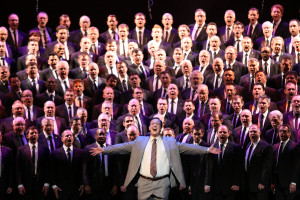We are all Harvey Milk
Anthony Rodgers | KCMetropolis.org
 “We gotta give them hope.” These words of Harvey Milk, the first openly gay person elected to public office, were taken to heart by the Heartland Men’s Chorus, who joined with the Gateway Men’s Chorus from St. Louis this weekend at the Folly Theater. After each ensemble sang selections of their own, Andrew Lippa’s large work I Am Harvey Milk received its Midwest premiere, forcing an element of introspection on the part of everyone present and a call for action to end all remaining hate.
“We gotta give them hope.” These words of Harvey Milk, the first openly gay person elected to public office, were taken to heart by the Heartland Men’s Chorus, who joined with the Gateway Men’s Chorus from St. Louis this weekend at the Folly Theater. After each ensemble sang selections of their own, Andrew Lippa’s large work I Am Harvey Milk received its Midwest premiere, forcing an element of introspection on the part of everyone present and a call for action to end all remaining hate.
The Gateway Men’s Chorus started the concert with a performance of Candlelight, a work by their conductor, Al Fischer; due to some timid sounds from the lower voices, the work was a bit unstable. However the ensemble quickly regrouped for a thrilling choral version of “Simple Joys” from Pippin to demonstrate their exceptional musicality. Intoning the words of John Donne, No Man Is An Island resembled the solemnity of a Germanic Requiem, and the chorus’s clean intervals sung at a soft dynamic were impressive. Borrowing again from musical theatre, GMC closed with “Light,” the final number from Next to Normal, unifying all of their works in a subtly inspirational set and what seemed to be their own tribute to the Harvey Milks of the world.
The Heartland Men’s Chorus began their segment with Dan Forrest’s The Music of Living, a subdued fanfare that showcased the sheer power of the men’s combined voices. I Met A Boy was a humorous and humbling juxtaposition of the years 1958, 1976, and 2010, highlighting societal changes in regard to homosexuality. A beautiful timbre was created at the beginning of Inscription of Hope, a piece remembering the Holocaust, by piano, string quartet, oboe, and a wordless choir. The rich, dark sound in the choir continued through the opening of Give ‘Em Hope, which gradually shifted to a lighter, gospel style, during which it was hard not to feel inspired to dance along.
I Am Harvey Milk was an ambitious project involving both choruses, three soloists, a chamber orchestra, and a great deal of projected imagery. Not a biographical work, the oratorio-like work instead examined various aspects of Milk’s life, asking the listener to examine his or her place in a changing world and find something relatable in the life and words of one iconic man. The voice of Milk haunted the hall before the large chorus began the movement “I Am The Bullet,” influenced by postminimalism, speaking to a silent population of opinion-less persons. Converting the Folly into a 1970s disco, “Friday Night in the Castro” was a lively number involving group choreography that was engaging overall, although risky at times when not everyone remembers to fully participate. As homosexual slurs were written on a screen like graffiti, the words echoed through the room with a modified version of the familiar rhyme “Sticks and Stones,” and as the terms shifted to include derogatory slang for racial groups, the global impact of hateful words grew realized and heavy. The projections were distracting at times, however, particularly during the beautiful “San Francisco.” Perhaps the most rousing of the numbers was the finale, “Tired of the Silence,” as Milk’s moving words rallied listeners to victory by being one’s self.
As Harvey Milk, Tom Lancaster was a perfect fit, bringing elements of his musical theatre background to this concert stage, truly embodying the icon himself. His voice during “You Are Here” was commanding, supple, and always under control. Portraying a young Milk, Cam Burns had a remarkable voice, full of the innocence and ambition desired from the character. Sylvia Stone, soprano, faltered often on sustained lines, going noticeably flat, but her stage presence was spot-on with each portrait, and the recitative sections in “Leap” were clean and easily understood.
Additional elements of the event included the well-balanced chamber ensemble that was never overbearing or overpowered. Sign language interpreter John T. Adams did more than offer his interpretive services, dancing along with the music happening behind him—an appreciated subtlety. The lighting effects were well done, always appropriate to the moods and lyrics of individual movements and pieces. All in all, these components worked together to convert an anticipated choral concert into the uplifting and inspirational event that it was, echoing the message of Harvey Milk that “hope will never be silent.”
